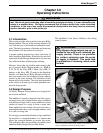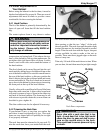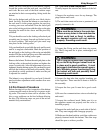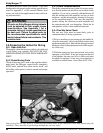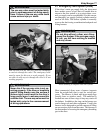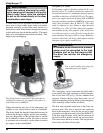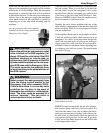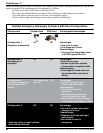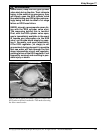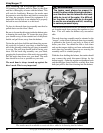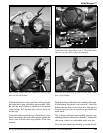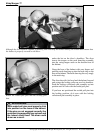
49
© Copyright 1970-2008 Kirby Morgan Dive Systems, Inc. All rights reserved. Document #080626002
Kirby Morgan 77
Make sure the emergency valve knob is turned off,
otherwise the emergency gas supply will be used up
without the diver’s knowledge. Once the emergency
supply hose is connected, the tank valve is turned on
to pressurize the hose. In the event of an emergency
due to a loss of the main gas supply, the emergency
valve knob located on the side block is turned on
supplying gas to the side block assembly and the
regulator.
Never dive without an over pressure relief
valve installed on the EGS regulator (1st
stage). Without the relief valve if the EGS
regulator develops an internal leak, or
carries-away, the full pressure of the EGS
cylinder would be placed on the low-pres-
sure EGS hose and the Emergency Valve.
This could cause the low-pressure hose
to burst resulting in the complete loss of
the EGS system.
WARNING
An over-pressure relief valve must be
installed on the first stage used for the
Emergency Gas Supply.
Never connect the main gas supply hose
from the diving control station to the
Emergency Gas valve assembly (EGS).
If this is done there is no one way valve
protection for the diver in the event of
damage to the umbilical or related equip-
ment. The diver could be exposed to a
serious “squeeze”. This can result in
serious personal injury or death.
WARNING
There are risks with each method of configuring your
bail-out system. There is a risk that if you have the
bail-out bottle on and the emergency valve on the
helmet closed, that the emergency gas could be lost
if the hose or the first stage itself develops a leak.
However, KMDSI believes that this method poses
the least amount of risk for the diver.
Probably the most serious problem with any of the
other possible configurations is that the first stage will
almost certainly flood if it is not pressurized while
you are underwater.
If the regulator floods and is not promptly serviced,
it will not perform properly when you need it in an
emergency. As a diver, you always must decide how
much risk and what types of risk you are willing to
expose yourself to when you dive. It’s up to each in-
dividual to make an informed choice regarding how
to configure your bail-out system. We cannot make
this choice for you.
Always be sure to check the pressure in your bail-out
bottle before you dive.
KMDSI strongly recommends the use of a submers-
ible pressure gauge with every bail-out system. Not
only does this make it very easy to check your emer-
gency gas pressure prior to diving, it also allows you,
in most cases, to periodically check the pressure in
your system while you dive. In this way, if you have
a leak, you will probably figure it out and will be able
to take appropriate action.



